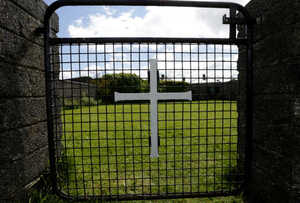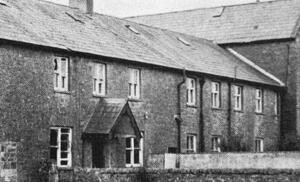The grounds (top) where an unmarked mass grave apparently containing the remains of nearly 800 infants who died at the Bon Secours mother-and-baby home in Tuam Co Galway from 1925-1961 rests. Attorney General Máire Whelan (above)
Solicitor Kevin Higgins and blogger Izzy Kamikaze spoke to Philip Boucher-Hayes on RTÉ One’s Liveline this afternoon in relation to the Tuam Babies story.
During the segment, Mr Higgins pointed out that the Attorney General Máire Whelan has the power to order a coroner to hold inquests into the deaths of any remains exhumed at the Tuam site. He said if she chooses not to exercise this power, she will inevitably face a legal challenge.
Philip Boucher-Hayes: “Kevin, you believe that with the, sorry, no pun intended, with the digging, but the trawling that you have been doing through the archives and the documents and so on, that the legal argument now for exhuming whatever is buried in the ground at the site in Tuam, and for holding coroner’s inquests, that that could no longer be resisted.”
Kevin Higgins: “I think that’s is absolutely true. I think the evidence, including public records is such that there simply must be an excavation of the site in Tuam to establish the truth of what lies beneath. And, as you’re possibly aware, there is a very specific statutory provision which confers absolute discretion on the Attorney General. It is in fact Section 24 of Coroner’s Act 1962 and I’ll read it for you if you wish.”
Boucher-Hayes: “Oh, don’t do that. Put it into English, please.”
Higgins: “Well, actually, it’s in remarkably plain English, remarkably plain English. It says “Where the Attorney General has reason to believe that a person has died in circumstances which in his opinion make the holding of an inquest advisable he may direct any coroner to hold an inquest in relation to the death of that person”.”
Boucher-Hayes: “Ok so, basically, the Attorney General can tell a coroner to hold an inquest.”
Higgins: “Indeed, and can indeed nominate a coroner of his, or indeed as it is today, her choice. And the discretion is particular and specific to the Attorney. It’s without reference to any minister or office of the State. It is entirely, the matter entirely rests with her based on the information available to the Attorney.”
Later
Boucher-Hayes: “Is there, from what you’re hearing from Izzy and from what you’ve assembled yourself, are you absolutely sure, in your opinion, as a lawyer and as an officer of the courts that there is enough evidence there to warrant the Attorney General going, taking on board what is going to be an immensely upsetting exercise for an awful lot of people living in that area, digging up what is under there and conducting inquests on the remains of God knows how many countless infant bodies.”
Higgins: “Yes, I do. I do think the evidence is overwhelming and I do believe that the Attorney will be inevitably confronted. I, like everybody else, I have regard for the Attorney’s experience as a lawyer and as a public official and I’m sure that she is aware of the powers she possesses under this section. I’ve no doubt that she is also a Galway woman and I imagine that perhaps gives her an additional interest. This is not very many miles from her own family home. The evidence, quite frankly, Philip is indeed overwhelming. It really is a matter of when this site, perhaps the first of many, is excavated and the manner in which it is undertaken.”
Later
Higgins: “I do believe the Attorney General is giving attention in this matter, I believe that she is acutely aware of the situation in the Mother and Baby Homes. This is inevitable because the Commission of Inquiry has been set up. I have no doubt that it is a matter of immediate concern to the Attorney’s office, inevitably, because of her role. I believe that she is, as I said, quite aware of the, of the discretion which she enjoys under Section 24 of the 1962 [Coroner’s] Act and I have every confidence that that matter is being actively looked at. I think if the, if there is any, if it comes into the public domain that the Attorney has considered the matter under Section 24 and decided not to exercise that discretion she enjoys, I do believe that the likelihood will be a legal challenge to that. I would very much hope that the Attorney would take the view that the exhumation, in the first instance, of the infants at Tuam is something which should be done in the public interest and would be a very proper exercise of her power.”
Listen back here
Previously: ‘It Seems Quite Probable The Babies Are Buried In The Sewage Tanks’
“Must Be Mounted With A Crucifix”
(Eamonn Farrell/Photocall Ireland)







Good stuff. Don’t let this one get brushed under that well-used Catholic rug.
Keep at it.
Move along, nothing to see here…
OK can someone help me out with this?
How does anyone know there is around 800 children, in the septic tank, without excavating it?
What’s the maths (or whatever) with this one?
Is there a septic tank book that the nuns kept?
without sounding flippant, yes. They kept a record of all burials
And also without wishing to sound flippant. If they kept a book, then you would think they could do better than the nearest hundred.
it does make you wonder. could it be 800 could it be more
Or zero.
Did they use a radar scanner of some sort?
To answer the questions being asked, 796 (not 800) deaths were recorded at the home. Burial records exist for only 2 of these (buried elsewhere.) 794 are presumed to be buried at the “Home.”
As the “Home” had no burial ground and was on a very cramped site, the most likely locations for burial are the (at least 9) sewage tanks on the site. Eyewitness accounts of burials match the description of these sewage tanks.
There is no way to know for sure how many are buried there without a full excavation of the site. As yet, even after months of controversy, nobody has proposed any alternative explanation for the missing burial records.
thank you Izzy. fair play